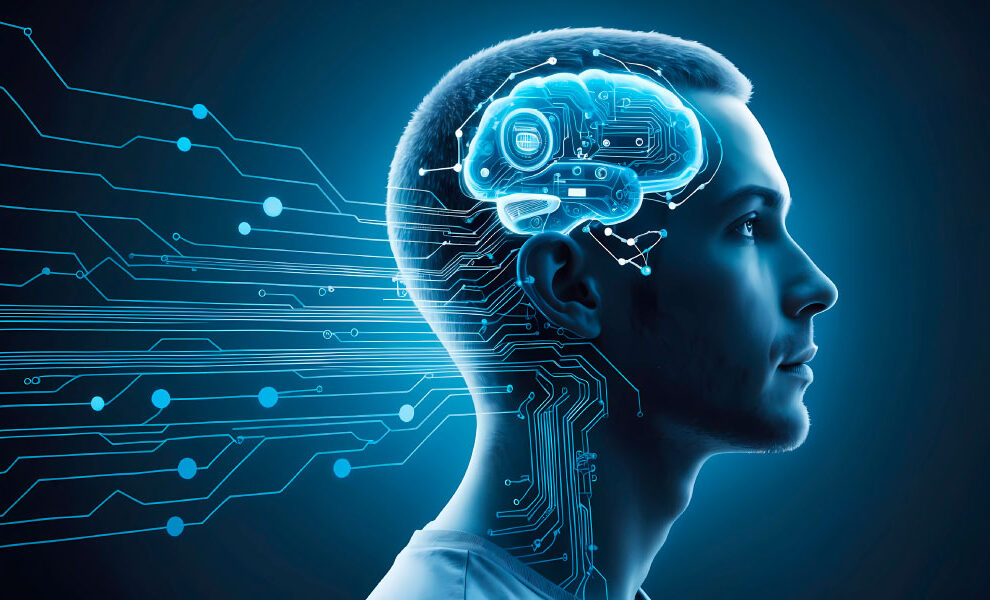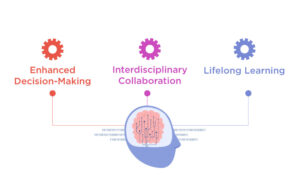The augmentation of human intelligence with AI has become essential in the technological landscape. With the advancement of technology new innovations are generated. The augmentation of human and artificial intelligence is considered to bring revolutionary changes in this world. The collaboration of human and artificial intelligence is known as augmented intelligence. This helps humans to make enhanced decisions. In this blog we will understand how augmenting artificial intelligence can collaborate with AI.
What is Augmented Intelligence?
Augmenting human intelligence is the capability to enhance human mental abilities by using AI. It involves tools that are designed to help humans to make informed decisions, solve problems, drive innovation, and increase creativity in work. By combining human skills such as empathy, creativity, and ethical reasoning with AI’s data processing power, humans can create innovative solutions that will be effective and will combine with human values. Sectors or industries where augmented intelligence is used;
Collaboration at Workplace
Across various industries, AI is already playing an important role, and it is enhancing human intelligence. For instance, in the healthcare sector, AI algorithms check medical images and suggest possible diagnoses. Though the final decision is taken by healthcare professionals, who rely on their expertise and knowledge of the patient’s situation, here AI helps to make well-informed choices. This collaboration will make more personalized treatment plans and accurate diagnoses.
Enhancing Creativity
Augmented intelligence is making a big impact in the creative sector. The AI-powered tools assist people in the creative sector, such as musicians, writers, artists, and others. It generates ideas, suggests improvements, and writes drafts as per requirement. For example, the AI program DALL-E, developed by OpenAI, creates images from descriptions given through text descriptions. Artists have combined their own ideas with AI-created content to make special artworks. In 2022, an artwork made by AI won a contest, leading to a discussion about how AI fits into creativity.
Education and Learning
Augmented intelligence can help customized learning to each student by observing what they are good at and where they need help. This combined approach helps teachers to focus on creativity and critical thinking, and also to students to learn effectively. For example, Duolingo, the language-learning app uses AI algorithms to adapt lessons based on user performance. This personalized approach has led to a reported 34% increase in user engagement, demonstrating the effectiveness of AI in enhancing educational experiences.
Ethical Considerations
As we explore the collaboration between human intelligence and AI, it is important to consider ethics. Value systems and habits of decision making among humans must be considered when designing AI systems. Transparency and accountability in the AI systems helps to build trust. By involving different perspectives while developing AI technologies will help to create common values and priorities.
Key Ethical Principles
- Transparency: Users should understand how AI systems are making informed decisions. It builds trust and ensures proper usage.
- Fairness: The development and training of AI should help minimize unintentional biases so that AI cannot unfairly discriminate against or disadvantage individuals or groups.
- Privacy: User data must be protected. Strong privacy standards are required for AI systems such that personal information is ensur
The Future of Collaboration
The collaboration of human intelligence and AI is expected to create new avenues in the industries. With the advancement of AI technology, we will get more innovative applications and opportunities to enhance our capabilities. This may include:
- Enhanced Decision-Making: This will help to provide deeper insights into an actual and timely decision-making process by leaders.
- Interdisciplinary Collaboration: As the overall use of AI is increasing in different kinds of sectors, researchers from different fields will join hands to explore this system fully, resulting in some striking innovations.
- Lifelong Learning: AI shall provide new avenues through which there would be immense opportunities for continuous learning so that individuals can learn new skills and adjust to new job markets. This will lead to a decision-making system, which results in creativity of people and will enhance learning experiences.
Benefits of Collaboration
- Increased Efficiency: As AI handles repetitive tasks, we can have time to work or focus on creative and strategic aspects.
- Better Decision-Making: AI can provide insights and data that help us make informed decisions.
- Continuous Learning: Working with AI provides us with new information and ideas, which helps to boost users personal and professional growth.
Challenges to Consider
Along with the possible advantages, there are a few challenges too. With this collaboration, we need to ensure that we use AI ethically and responsibly. It is essential to maintain human oversight and ensure that AI systems are transparent and fair.
Final Words!
Augmenting human intelligence with AI is more like a collaboration than a replacement. By augmenting our capabilities with AI, we can enhance decision-making, foster creativity, and improve learning experiences. This partnership allows us to use the knowledge or capabilities of humans and machines, leading to innovative solutions and a bright future. By working together, we can tap into human potential in combination with machine capabilities to build a brighter future for mankind. Together, we can create a world where human and artificial intelligence work in sequence to unlock new possible things and drive a progressive future for all.
For more trending topics, check HiTechNectar!
Also Read:
8 Ways to Use Artificial Intelligence in Research Projects
4 Use Cases Guide of Artificial Intelligence for Better Customer Experience



